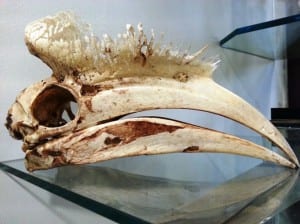Why Twitter is good for museums – making discoveries
By Jack Ashby, on 9 April 2014
Using Twitter as a way of building a community of support, engaging people in content and shedding light on life behind the scenes in museums (that we don’t just dust stuff) is too obviously demonstrated by the real world to be spending too much time discussing. Not to mention the power to market events and exhibitions quickly and cheaply – assuming don’t over-use social media as a marketing tool.
On Monday I conducted two pieces of “research” on our collection which sprung up out of the blue and would have been very difficult to solve without turning to our Twitter followers to tap their collective brain to find a quick answer. Both of them were on specimens that begin with “H” and end with “Bill”. Weird.
Tweeting Turtles

Hawksbill turtle showing his interesting eyes LDUCZ-X1177
I was standing in the Museum office and glanced at the hawksbill turtle that had been taken off display to be used in this week’s “Easter Egg-Laying Animals” holiday activities. I see this specimen daily on display, and indeed got rather intimate with it while we were mounting it in flying duck formation on the back wall. I’d never paid much attention to its eyes though.
The specimen belongs to our HM Revenue & Customs collection – specimens of species protected by the Convention on International Trade in Endangered Species are confiscated crossing borders when people illegally import them. We have three hawksbills that were prepared as souvenirs – two are over-polished but look very nice as a result – and it’s quite possible that the ignorant tourists who bought them didn’t know it was illegal.
Looking at this specimen’s eyes I was struck by how much they looked like cowry shells. Cowries are tropical snails with beautiful shells, which were famously used as currency by some societies. Many species have a kind of eye pattern on them. The two eyes were slightly different (though made of the same thing) – more different that one would expect if they were hand-painted glass eyes.
I took to Twitter to see if the rest of the world agreed with me. Snails, and indeed the history of taxidermy are not my areas of expertise. Very quickly I heard back from David Notton, a senior entomology curator at the Natural History Museum, who suggested they were the opercula from Turbo snails (so I wasn’t far off). Opercula are hard discs attached to the foot of many snails that they use to seal the shell when their soft bodies are retracted inside.
I actually have a Turbo snail operculum in the geeky personal museum in my bathroom (every museum-bod has such a shelf somewhere at home), so that’s slightly embarrassing.
As this was just a moment of piqued curiosity that came about through happenstance, I would never have gone to the trouble of seeking external curatorial input more formally to identify the eyeballs. Twitter offered an instantaneous response to a quick question, posted via a photo while I waited for the kettle to boil. We now know something really interesting about one of our specimens (and now the curatorial staff have a decision to make over how to document an specimen containing three animals from two phyla).
Tweeting hornbills
Also on Monday I was doing the final batch of edits on about 600 new labels that we are developing for the Museum. We have an extremely weird hornbill skull on display that we know so little about we haven’t been able to write a label for it.
Hornbills have a casque on top of their heads. In some cases this is hollow and used in resonation, in others it is solid bone (hornbill “ivory”). In this specimen we see a weird honeycomb that disappears to nothing. Such as it is, we can’t write a label just talking about hornbill casques as the specimen that would go with that label is clearly atypical and would leave people confused.
We have long suspected that the specimen looks this way as it was over-prepared by a curator down the line. Bird bone is very light and porous, and as such doesn’t take much to dissolve it away. But we also realised it the strange casque could possibly be pathological in the individual bird, or a species we weren’t familiar with.
Once again I asked Twitter. Almost instantly TV’s (and UCL’s) Ben Garrod replied to confirm that it is likely a result of over boiling.
Using Twitter as an engagement tool is an obvious benefit for museums to reach the public, but because so many museums, museum people and academics are using Twitter it also makes it a fantastic resource to instantly tap the expertise of other professionals out there. These are just two little snippets we found about our collection in a matter of minutes. It’s also probably quite interesting for our more “public” followers to read.
Jack Ashby is the Manager of the Grant Museum of Zoology.
 Close
Close




